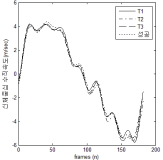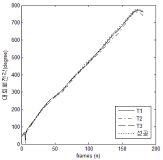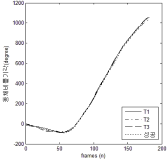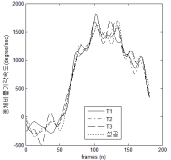 ISSN : 1598-2920
ISSN : 1598-2920
When the long-awaited KSME in PESS was established in 1998, KSME faced a turning point in its growth. Following the changes in both quality and quantity of the society's researches since its establishment and seeking for future themes is important for the society. This research analyzed the society's research trend using mainly the Korean Journal of ME in PESS. Then, by examining the physical fitness test, it proposed possible future themes for the KSME. This research also looked into the American Kinesmetrics’ contribution to Kinesiology, its research trend and future researches The KSME's recent researches show refined quality, diversified themes and reinforcements in practical researches. Regarding the themes, the reliability and validity of tests became predominant, sports analysis and physical activity emerged, and interest in measurement and evaluation in school PE was low. Possible research themes in the future are measurement and evaluation in school PE, game analysis and sport big data. The recent interest of the American Kinesmetrics was the cross validation of criterion-referenced physical fitness cut-off score, the validation of the guideline for physical activity, and the relationship between sedentary behavior and health. Possible future research themes of the American Kinesmetrics were the refinement of test methods, the effectiveness of the physical fitness test award system, and the application of the ubiquitous wearable technology.

Although delayed heart rate recovery (HRR) and impaired autonomic nerve system (ANS) modulation after acute exercise are related with cause of cardiovascular disease (CVD) and mortality, studies evaluating ANS changes with local exercise are still unsatisfied. Thus, this study aimed at investigating the modulation of ANS-related parameters, followed by upper or lower body exercise. Eleven male without cardiovascular and orthopedic diseases measured basic body composition, resting blood pressure (BP), and heart rate variability (HRV). This study based on randomized cross-over design; AE composed with arm-ergometer, and LE involved with leg cycling. Participants had at least one week wash-out between each exercise, also there was no cool-down after exercise. All sessions were performed with intensity of 50 % target heart rate for 30 min. With measurement of Rating of perceived exertion (RPE) during every 10 min, HRV was measured Kubios HRV software using R-R intervals collected with Polar RS800CX in post-exercise recovery (for 30 min). As a result, heart rate (HR) and RPE were same (p > 0.05) through the experiment. As results of this study, SDNN and rMSSD in time domain on LE were higher than on AE during post-exercise recovery. When LE compared with AE used by Poincare plot, both parasympathetic reactivation (SD1) and autonomic nerve regulation (SD 2) on LE were higher than AE. Immediately after submaximal exercise, the high-frequency component on LE was significantly greater compared to AE. Also, the LF/HF ratio and LF nu reflecting sympathetic activity were higher on AE than LE. In contrast, the HF/TP ratio and HF nu reflecting vagal tone were greater on LE than AE. In conclusion, this study suggested regional lower body exercise recovers more sufficient than regional upper body exercise after submaximal aerobic exercise at same HR. Local exercise like leg cycling needs a careful approach to apply for accurate exercise prescription and effective training.

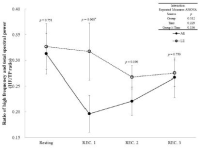
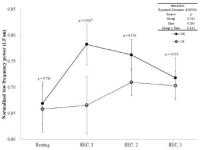
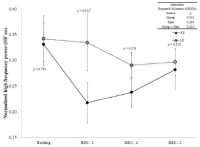
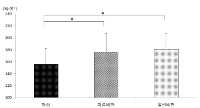
This study was designed to compare physical fitness, blood lipids, and insulin resistance according to body mass index (BMI) and percent body fat (%BF) in 20s females. Sixty women, aged 20-29 yrs, volunteered to participate in the study as subjects. There were three groups, i.e., normal group (BMI < 24 kg·m-2 and %BF < 25%; n = 25), normal weight obese group (BMI < 24 kg·m-2 and 28% < %BF < 40%; n = 22), and obese group (BMI > 26 kg·m-2 and 30% < %BF < 40%; n = 13). Physical fitness, blood lipid profiles, and surrogate indices of insulin resistance were measured and compared among three groups. Main results of the present study were as follows: 1) There were significant differences in all variables regarding body composition among three groups. All values were lowest in normal group and highest in obese group. 2) There was significant difference in sit-and-reach among three groups, whereas no significant differences were found in other variables regarding physical fitness among three groups. 3) There were significant differences in all variables regarding blood lipids among three groups. In particular, total cholesterol (TC), low density lipoprotein cholesterol (LDL-C), TC/HDL-C ratio, and LDL-C/HDL-C ratio were significantly higher in normal weight obese group than normal group. 4) There were significant differences in all variables regarding insulin resistance among three groups. Fasting plasma glucose and HOMA-IR were lowest in normal group and highest in obese group. It was concluded that there would be abnormal blood lipid profiles and insulin resistance in even normal weight obese individuals as well as general obese individuals in 20s females.


Frailty in older adults is related to an increased risk for poor health outcomes including falls, disability, hospitalization and mortality. The purpose of this study was to determine the thresholds of a functional fitness associated with frailty for community-dwelling woman aged 65 or older. In this study, the National Fitness Award(NFA) items for elderly were utilized as the physical function and fitness testing for korean elderly women. The total of 444 community-dwelling woman completed the testings. Frailty status was classified by the Japan LTCI system ‘Kihon Checklist’ in the study. The prevalence of the frailty was 19.1% in the study. The frail elderly were older and showed higher obesity index such as weight, body mass index (BMI), percent body fat and waist circumference than the normal elderly. After adjusting for age and BMI which was related to frailty, fitness testing items were compared depending on frailty. As the result, the frail elderly showed significantly lower fitness levels in grip strength, 30-second chair stand test, timed up and go, figure-of-8 walk around two cones, and 2-minute step test than the normal elderly. When the fitness cut-off values were analyzed using the ROC curve, also, grip strength: 34.13%, 30-second chair stand test: 14 reps, timed up and go: 7.09 seconds, figure-of-8 walk around two cones: 30.88 seconds, and 2-minute step test: 93 reps. In addition, based on the cut-off values of each fitness item, the group with a low fitness level showed a 1.86 to 3.09 higher odds ratio of frailty than the group with a high fitness level, even after age and BMI were adjusted. In conclusion, these findings indicate that the fitness cut-off values in this study are fitness levels for preventing frailty of Korean elderly women and there will be a need for a large-scale study including subdivided fitness cut-off values for each age group and targets elderly men as well.
This study aims to provide an in-depth study on K-League players' perception and preparation process on retirement. In order to achieve the purpose, data collection was conducted in two major ways; face-to-face interviews and questionnaires from 10 currently working players. The result of study is based on inductive analysis. First of all, sense of expectation and concern, limited scope of secondary job, and necessity for career education are appeared in terms of players' perception. Second, preparation process on retirement is concluded in two categories; personal development activities(non-professional and inefficiency) and financial preparation. Thirdly, difficulties in the procedures of retirement preparation are categorized into ‘limited time and isolated lifestyle caused by staying in club house ’ and ‘lack of educational programs regarding retirement’. Depending on the results of this study, opportunities confined to retired players are supposed to be enlarged to currently working players. In addition, football club and K-League federation need to support players not only to enhance performance but also to prepare retirement.

The purpose of this study was to evaluate sports commentators’ public confidence by the difference between media recipients’ expected level on the public confidence and their perceived outcomes, and to investigate how such characteristics are perceived by media recipients. The questionnaires were given out to people in Seoul and Gyeonggi province, who have experience of having watched the 2014 FIFA World Cup Brazil. The samples were collected by snowball sampling method and a total of 218 questionnaires were chosen as final validity sample. For data analysis, frequency analysis, exploratory factor analysis, paired t-test, importance-performance analysis (IPA), PROXSCAL analysis, and a multiple regression analysis were done by using PASW 21.0. The derived results are as follows: First, according to results from IPA analysis, the Quadrant I is a status-quo area, which is inclusive of the professionalism of KBS and SBS commentators. The Quadrant Ⅱ is a concentrated effort-oriented area, which includes dynamics of KBS and SBS commentators, and professionalism and dynamics of MBS commentators. The Quadrant Ⅲ is an inferiority ranking area, which contains popularity of KBS and SBS commentators, and reliability of MBC commentators. The Quadrant Ⅳ is a rejection of overexertion area, which incorporates reliability of KBS and SBS commentators and popularity of MBC commentators. Second, according to results from MDS analysis in terms of the characteristics of public confidence, an order of KBS>SBS>MBC appeared in the fields of professionalism, reliability and dynamics, and an order of KBS>MBC>SBS appeared in popularity.


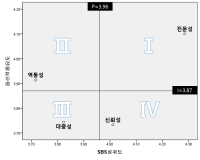

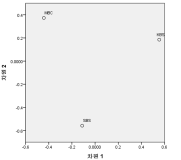
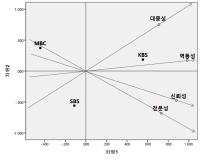
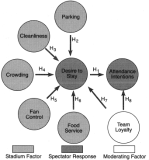
This study employed a sportscape model to analyze environmental impact on spectators’behavior. In addition, the loyalty construct in the sportscape model was reanalyzed based on the theoretical framework. Five hundred questionnaires were distributed to the spectators of World University Taekwondo Championship, and 418 questionnaires were used for data analyses. The analyses of measurement and structural models were conducted using SPSS 18.0 and EQS 6.2 programs. The results indicated that the measurement model showed acceptable reliability and validity. The structural analysis showed that five stadium factors (parking, cleanliness, crowding, food service, and fan control) have significant effects on spectators’ desire to stay and to revisit the stadium. Loyalty also positively affected revisit intention. This study emphasizes sport environment to make spectators revisit and provides future research suggestions to improve the sportscape model.



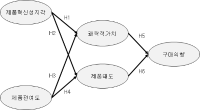
The aim of this study is to empirically verify the relationships between innovativeness perception of and involvement in sports products, and hedonic value, product attitude and purchase intention through the structural equation model. For this purpose, this study conducted a questionnaire survey of 291 college students in Chungcheong region. Sampling method was Quota Sampling Mode, and questionnaire has been structured to be self-administerd type. SPSSWIN Ver. 21.0 and AMOS 18.0 have been used for data processing. As a result, first, it was found that innovativeness perception had a positive influence on hedonic value; second, innovativeness perception had a positive influence on product attitude; third, product involvement had a positive influence hedonic value; fourth, product involvement had a positive influence on product attitude; fifth, hedonic value had a positive influence on purchase intention; sixth, product attitude had a positive influence on purchase intention. Such results imply that it's not desirable to overlook the level of innovativeness perception & involvement from a corporate perspective when an enterprise develops and launches new sports products.


The purpose of this study was to analyze the effects of employee’s job burnout on turnover intention and to draw average effect size(weighted averaged fisher’s z) in sports industry. After a lot of dissertations and journal articles were extracted by searching web sites, 11 papers were finally selected through thorough verification procedure. Specific analyses were conducted via MIX 2.0(Meta-analysis with Interactive eXplanations). The results were as follows. First of all, the weighted average correlation coefficient of between depersonalization and turnover intention was .326. Secondly, the weighted average correlation coefficient of between reduced personal accomplishment and turnover intention was .192. Lastly, the weighted average correlation coefficient of between emotional exhaustion and turnover intention was .326.


This study was to identify the perception on retirement for professional soccer players as a basic study for the development of career transition program, Professional soccer K-League(K-League Classic, K-League Challenge), N-League(Club League), K3-League(Challenger League) league players registered in 2013 were selected as a population. Structured questionnaire surveys were utilized for the research, total of 1000 questionnaires(250 per league) were distributed and gathered. Final sample of 548 questionnaires were analyzed excluding people which do not respond properly. SPSS was used to identify the characteristics of the responder in frequency analysis. One-way ANOVA was used to find the difference in retiring causes among the leagues, Pearson Correlation analysis was used to examine the correlations among the variables. Multiple regression analysis was used to find the effect of economic and psychological preparation on plans after retirement. The results were as follows. First, among the causes of retirement, 'contract suspended', 'seek other life', 'family issues such as marriage' showed the difference in perception of retirement according to the leagues. Second, psychological preparation was more focused than economic preparation to prepare for retirement planning among players, respectively.

Based on the expanding concept of public value in most of areas as well as in public administration, the purpose of this study is to explore the meaning and functions of public value in sport pedagogy in Korea. For doing this, this paper has classified the concept of public value into classical and modern concepts and re-conceptualized it throughout diverse concepts implemented in several areas (e.g., social welfare, media, & culture-arts). Thus, this paper has explored the meaning of public value in sport pedagogy for analyzing the common element among the public values of sport, education, and scholarship. The public value of sport pedagogy is conceptualized as ‘the discipline that has inquired the public knowledge and also that has been served the instrumental role for making better society’. In addition, this paper has suggested the conceptual framework to extend the areas that can be applied the public value of sport pedagogy inside and outside in Kinesiology with reflection about academic and practical activity of Sport Pedagogy. Lastly, this paper has searched the multiple functions of public value in Sport Pedagogy such as educational, cultural, integrative, and global functions that could connect the academic and professional activity of Sport Pedagogy into making the public value of Sport Pedagogy.


As an attempt to think about the popularization of Korean sport history, this paper discusses three main things. First, it will be introduced what public/popular history is, how it has been developed, and why it is important to history as an academic discipline. Second, it will be summarized how sport historian embraced public/popular history into their practices in terms of what theoretical, critical, and methodological aspects they have focused. Third, I will discus why public/popular history is useful in the ways in which Korean sport history envisions its popularization in Korean society. To be more specific, I highlight two ideas: an insight for understanding sport history as a process and sport historiansʼ role of critic. Based upon these two, I will argue that Korean sport historians might need to actively embrace practices of public/popular history into their studies of the Korean sporting past.
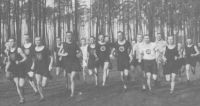
The research is to shed new light to historical meaning and value of Carl Diem who was a pillar of modern sports in Germany and also served as an athlete, PE administrator, journalist, sports scholar and dean of a university. He has been highly regarded in Korea as a trail-blazer of German sports, but in his own country, he who once served as the secretary general of the 1936 German Olympics was at the center of controversy since he was named as a pro-Nazi, and even the name of a place named after him was deleted. Having said that, as an athlete, he played a huge role in organizing sports clubs where he worked as an chairman; organized and held various sports competition events; laid the academic groundwork for the modern sports in Germany by majoring in Sports in the United States. Above all, he is the one who came up with the torch relay and staved to define the significance of the Olympic Games by founding the International Olympic Academy. His academic and practical capabilities were proven through the establishment of Deutsche Sporthochschule Köln, also known as German Sport University Cologne. And Carl Diem Research Institute is still up and running to this day. Thus, in this research, I’d like to take a look at his passion for sports and changes of German sports including the German Olympics and offer a multi-faceted view on him who was evaluated during a historical turmoil back then.

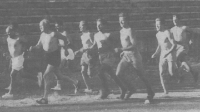
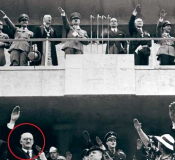
The purpose of this study was to examine psychological capital acquisition through Asian Games Participation. 17 of national women football players were completed Psychological Capitals Questionnair. The psychological capital consists of optimism, psychological skills, self-management, collective efficacy, and performance perception was investigated after the team call-ups and before the team-release. The data was analyzed by paired t-test. As results, Korean women football players’ collective efficient and performance perception showed a statistical significance at the beginning of the team call-ups but optimism, psychological skills, and self-direction did not show statistic significances. The team-harmony, interpersonal-management, team-power, sufficient training, trust in coach, efficient communication, and psychological football factors, which were subfactor of football players’ psychological capital, showed statistical significances. However, confidence, concentration, goal-setting, imagery, willpower, anxiety-control, mental-management, life-management, training-management, innate-behavior management, physical-management, football skills, mediative skills, and football intelligence factors did not have statistic significances. These results demonstrate that effects of mega sporting events-like experiences and psychological factors’ variability and inflexibility according to weather changes should be considered when it comes to discussion of psychological factors regarding players’ performance. It is expected that this study would be a fundamental resource for understanding of psychological influences through participations in mega sporting events and discussions about further psychological interventions for teams with environmental consideration as well as methodological developments which could measure effects of the psychological interventions.

This study was to verify the structure of efficacy related to performance perceived by short-track athletes when playing a match. Therefore, 50 players answered open questionnaires and 200 players participated in construct validity verification, a total of 250 players of short-track members of national, business and university team were sampled during the research phase. The data was analyzed through the study procedures. The results were as follows: First, efficacy structure of players during the match were categorized into three groups as game managing strategy(including course management, race control, match management and selective attention ability), psychological control ability(including positive imagery, match competition, competitive spirit, ability to handle hardship, anxiety control, and patience), and physical usage of ability(including physique, endurance, and quickness). Second, the result of the first construct validity verification through exploratory factor analysis showed 7 factors in 29 items as game management, course management, psychological control, physical use, coping with hardship, speed control and psychological stability. Finally, as a result of confirmatory factor analysis, short-track self-efficacy showed the 5 factor in 15 items except for coping with hardship and psychological stability.

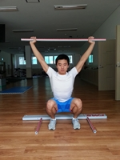
The purpose of this study was to examine the effect of the functional movement improvement training program on the score of high-school baseball players’ functional movement screen (FMSTM) test. After 16-weeks treatment period, a significant increase of Deep Squat, Hurdle Step, In-Line Lunge, Shoulder Mobility, Active Straight Leg Raise, Rotary Stability, and total score was found only in treatment group. There was decrease on the number of players in treatment group whose total score is less than 14; the criteria vulnerable being injured. The results of this study suggested that applying functional movement improvement training program on high-school baseball players can be effective to prevent injuries.

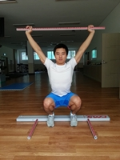

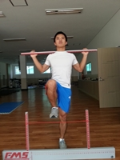
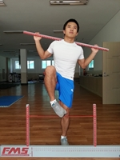





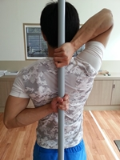

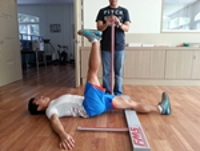
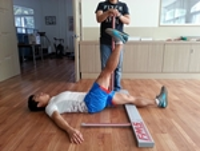


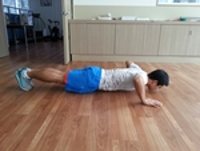




The aim of this study was to evaluate gender differences of expert and non-expert in match playing time, moving distance, energy consumption and heart rate (average, maximal) during 16 simulated badminton matches in male (n = 16) and female (n = 16) national elite players. The players had perform three sets on same day, and this time observed the playing time, moving distance, energy consumption and heart rate (resting, average, maximal) level during badminton match. Analyses of variance with repeated measures were used to test any significant time×group interaction effects on the measured variables. Statistical significances were tested at p = 0.05 with spss-pc (version 18.0). As a result, male's player had significantly difference between expert and non-expert in moving distance (p=.012), energy consumption (p=.003), average heart rate (p=.002) and maximum heart rate (p=.002). Female's players showed significant difference between expert and non-expert in moving distance (p=.001) and energy consumption (p=.012). In conclusion, there seemed to be an increased playing intensity (i.e., moving distance, energy consumption, average heart rate and maximum heart rate) from expert than non-expert in gender differences. These results suggest that men male's players with expert performed the game at a higher intensity than compared to non-expert, on the other hand female's player with non-expert showed that more activity and energy consumption was unclear during the game

The research was a case study conducted in order to develop a new technique “YANG Hak Seon 2” for YHS athlete. A comparative kinematical three dimensional video analysis was performed with the use of high speed cameras. One successful trial and three of failure trials (T1: Falling backward while landing, T2: sitting reluctantly while landing, T3: Falling of sideways while landing). The result obtained from the study are as follows. Firstly when comparing the successful operation of the technique with failure trials, relatively higher landing angle was secured through increasing the thigh rotation and the body’s rotational velocity. Furthermore, despite increase in rotational velocity at twisting, stable landing was achieved through increasing the moment of inertia by spreading the left shoulder. Secondly, in case of failure trials while taking off the board, the thigh rotational angular velocity was comparatively less which ultimately affected the body position in the next phase of approach to the vault. Thus, due to the affected body position the athlete was not able to utilize the proper momentum of twist in positive direction Hence, it is considered that the velocity of center of mass might have also effected the operation not only the velocity while approaching the board.






